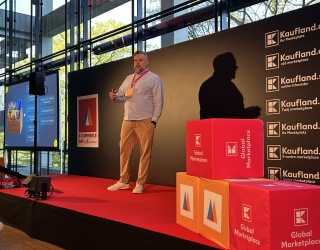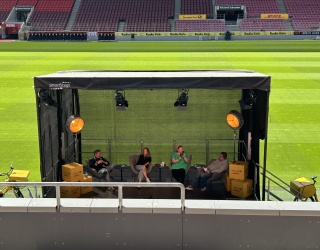
What is the best way to connect my online store with my branch offices?“ This is a question many retailers are currently asking themselves. We spoke with Eric Jankowfsky, Managing Director of Jankowfsky AG, about the challenges for retailers and the influence of mobile commerce.
Mr. Jankowfsky, mobile shopping is a growth market and more and more retailers also offer mobile stores. What do they need to consider in terms of the conceptual design for this type of store?
Lately, many in the industry sector talk primarily about responsive design and the importance of designing the entire online store in a responsive way. From my point of view, this is not the right thing to do. However, it definitely makes sense to adapt the landing page to the corresponding end device for example. After all, customers often end up on this page via links provided in a newsletter. And since more and more people only read their emails on their mobile devices at this point, those links should also provide a screen that is suited for a Smartphone. That’s why retailers should choose a store architecture that can be well displayed on stationary and mobile end devices. Responsive design actually only benefits individual store elements.
What factors are the most important for customers in this case?
Clearly usability. The customer decides where he shops and whether he uses the online store via the computer, the Smartphone or a tablet. Good usability for every end device is essential for the shopping experience and in some cases makes the difference of whether a purchase takes place or not.
Keyword multichannel commerce: What must a retailer do today to successfully combine his brick-and-mortar with his online stores?
One essential factor is shared access to inventory both in the warehouse of the online store as well as the brick-and-mortar shop. Only when that works properly, can click&collect models be intelligently implemented for instance. In practice, this usually falls short due to the outdated inventory management and POS systems many retailers still use. When it comes to franchise models, even individual franchisees often use entirely different types of software. Of course, converting to a new system – across all stores – means investments that many still shy away from. After all, you need to also buy the latest hardware, such as Internet-enabled terminals for instance. However, only when all parts of the company work with the same database can all products and services be successfully combined.
Doesn’t the success of (mobile) eCommerce mean that brick-and-mortar retail ultimately becomes less important?
Since the early days of eCommerce, it has been hailed as the “future of shopping“, yet today it still only has a market share of 10 percent. At the same time, many brick-and-mortar retailers have had an intense feeling of doom for many years and yet they still hold a 90 percent market share. I believe this way of looking at things is something of a paradox.
Of course, the buying patterns change with the new possibilities, but there will always be a market for both sides since they meet different customer needs. It is simply more convenient to make quick purchases for standard everyday products online. Yet there will also always be product groups for which customers are willing to drive to town for to get personal, professional service.
Today more and more brand manufacturers also choose to utilize the online distribution channel to reach the end customer directly. What do they need to look out for in particular?
Generally, the same applies to these manufacturers as does to the traditional retailers. However, it is somewhat more difficult for them to implement this since they haven’t previously been in direct contact with the end customer and first need to learn to focus on the consumer. Yet an accurate forecast is hard to make, in this case since given the same product, it is naturally entirely up to the customer to either shop at a retailer’s store or directly from the manufacturer. In this case, it is essentially only possible to truly distinguish yourself from the competition with the price.
What do you think this means for traditional retailers? Are customers going to only buy direct from manufacturers in the future?
Definitely not. Those customers, who prefer to directly shop at the manufacturer are those with the highest level of brand affinity. A manufacturer should pay special attention to those, particularly loyal customers. After all, when somebody feels this attached to a brand to where they might even pay a higher price to buy directly from the manufacturer, they also make great brand ambassadors. This is something the manufacturer can only benefit from of course.
Aside from that, the advantage a retailer always has over the manufacturer is, of course, the size of the product selection. If I want to purchase a new suit, I don’t just need a pair of trousers and a jacket, I also need a matching shirt, shoes, and a tie. Very few customers would be willing to order from four different brand manufacturers for this type of purchase. Instead, they shop at the retailer who offers all of these products – and ideally also benefit from expert advice.
What are the products and services Jankowfsky AG helps retailers to face these challenges with?
Our strength lies in adapting today’s standard technology to the individual needs of a retailer. For instance, we offer POS terminals that grant the customer access to the entire portfolio of a retailer, not just the potentially limited number of products in the store.
In this case, brick-and-mortar retail is being directly connected to the online store on the sales floor. Customers are able to order a product directly at the POS, even if it is presently not available at the store. At the same time, we can analyze all of the terminals and find out which products are most sought-after for example. The retailer can subsequently adapt his selection at the store and generate more sales with the most popular products. He might even be able to reduce the size of the sales floor and achieve further savings. Thanks to an intelligent logistics approach, the retailer can subsequently present more suitable products in a smaller sales area.
We also offer mobile tablet-based POS solutions. The advantage here is that the sales associate can approach the customer directly at the product, advise him and close the sale there. Additional features such as an item recommendation function are also an option if the corresponding customer information is available.
Interview by Daniel Stöter, iXtenso.com








